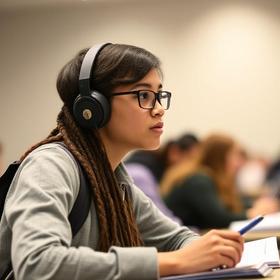School Highlights
Living Arts College serves 171 students (87% of students are full-time).
The college's student-teacher ratio of 3:1 is lower than the state community college average of 13:1.
Minority enrollment is 71% of the student body (majority Black), which is more than the state average of 48%.
Quick Facts (2025-26)
- Enrollment: 171 students
- In-state tuition: $86,040
- Out-state tuition: $86,040
- Acceptance Rate: 100%
- Student-teacher ratio: 3:1
- Minority enrollment: 71%
- Source: Integrated Postsecondary Education Data System (IPEDS)
Top Rankings
Living Arts College ranks among the top 20% of public schools in North Carolina for:
Category
Attribute
School Overview
The teacher population of 55 teachers has stayed relatively flat over five years.
Living Arts College
(NC) Community College Avg.
Carnegie Classification
Not applicable, not in Carnegie universe (not accredited or nondegree-granting)
Associate's Colleges: Mixed Transfer/Career & Technical-High Nontraditional
Institution Level
Less than 2 yrs
At least 2 but less than 4 years
Institution Control
Public
Public
Total Faculty
55 staff
256 staff
School Calendar
Student Body
The student population of Living Arts College has declined by 26% over five years.
The student-teacher ratio of 3:1 has stayed the same over five years.
The Living Arts College diversity score of 0.63 is less than the state average of 0.66. The school's diversity has stayed relatively flat over five years.
Total Enrollment
171 students
2,579 students
Student-Teacher Ratio
3:1
13:1
# Full-Time Students
149 students
766 students
# Part-Time Students
22 students
1,813 students
# Enrollment Undergraduate
320 students
316 students
# Full-Time Undergraduate Students
149 students
766 students
# Full-Time Graduate Students
n/a
22 students
# Part-Time Undergraduate Students
n/a
1,990 students
# Part-Time Graduate Students
n/a
3 students
Total Dormitory Capacity
n/a
717 students
% American Indian/Alaskan
2%
1%
% Asian
n/a
3%
% Hispanic
9%
13%
% Black
52%
21%
% White
29%
52%
% Hawaiian
n/a
1%
% Two or more races
4%
3%
% Non Resident races
1%
1%
% Unknown races
3%
5%
Diversity Score
0.63
0.66
College Completion Rate (Students who graduate in less than 4 years)
54%
19%
College Completion Rate (Students who graduate in 4 years or more than 4 years)
63%
43%
Average Graduate Earnings (10 Years)
$39,200
$27,500
Tuition and Acceptance Rate
The public in-state tuition of $86,040 is more than the state average of $3,915. The in-state tuition has grown by 403% over four years.
The public out-state tuition of $86,040 is more than the state average of $9,508. The out-state tuition has grown by 403% over four years.
In-State Tuition Fees
$86,040
$3,915
Out-State Tuition Fees
$86,040
$9,508
Tuition Notes
Differs from $18k to
% Students Receiving Some Financial Aid
90%
82%
Median Debt for Graduates
$13,805
$11,865
Median Debt for Dropouts
$5,500
$5,846
Acceptance Rate
100%
82%
SAT Reading
n/a
488
SAT Math
n/a
498
ACT Composite
n/a
20
ACT English
n/a
13
ACT Math
n/a
16
Source: 2023 (or latest year available) Integrated Postsecondary Education Data System (IPEDS) , School Administrators
School Notes
- We offer 6 programs in digital creative fields with several degree and diploma options. They are Animation and Game Design, Audio Production, Filmmaking, Interior Design, Media Arts and Photography. We also offer 3 Medical Art programs with Diploma. They are Medical Assistant, Medical Billing and Coding and Medicial Adminstrative.
- Sample of notable school alumni/alumnae:
- Graduates of the first class included students who worked on the first Star Wars digital series. -
Frequently Asked Questions
How much does Living Arts College cost?
Living Arts College's tuition is approximately $86,040 for In-State students and $86,040 for Out-State students.
What schools are Living Arts College often compared to?
Living Arts Collegeis often viewed alongside schools like Wake Technical Community College, William Peace University by visitors of our site.
What is the acceptance rate of Living Arts College?
The acceptance rate of Living Arts College is 100%, which is higher than the state average of 82%.
Who are famous alumni from Living Arts College?
Living Arts College famous alumni include: Graduates of the first class included students who worked on the first Star Wars digital series..
What is Living Arts College's ranking?
Living Arts College ranks among the top 20% of community college in North Carolina for: Average community college minority breakdown.
In what neighborhood is Living Arts College located?
Living Arts College is located in the North Raleigh neighborhood of Raleigh, NC.
Recent Articles

Best Community Colleges by Career Path in 2025
Explore top community colleges for career-training programs in 2025, including healthcare, IT, skilled trades and business pathways.

Dual Enrollment in High School: Benefits, Risks & Real Student Results
Explore the pros and cons of dual enrollment in high school, real outcomes for students in 2025, and how to decide if it’s right for you.

How to Transfer from Community College to a Four-Year University Without Losing Credits
Learn how to transfer from community college to a four-year university in 2025 without losing credits. Expert advice, timelines, and credit-transfer strategies.









